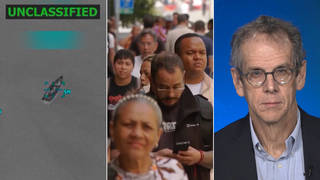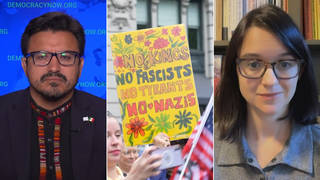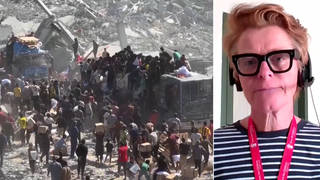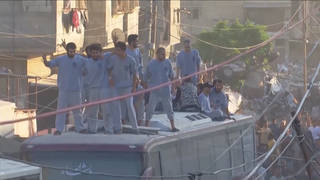
Eight men are on trial in Honduras for the murder of environmentalist Berta Cáceres, who was gunned down in her home in La Esperanza in 2016. A verdict is expected this week. The assassination of Cáceres came a year after she won the Goldman Environmental Prize for her work protecting indigenous communities and her campaign against a massive hydroelectric dam project. We speak with Dana Frank, professor emerita at the University of California, Santa Cruz. Her new book is titled “The Long Honduran Night: Resistance, Terror, and the United States in the Aftermath of the Coup.”
More from this Interview
- Part 1: Brother of Honduran President Is Arrested for Cocaine Trafficking as Migrants Flee Violent Drug War
- Part 2: “It Is Not a Natural Disaster”: Dana Frank on How U.S.-Backed Coup in Honduras Fueled Migrant Crisis
- Part 3: Honduras: As Berta Cáceres Murder Trial Nears End, Will True Perpetrators Be Brought to Justice?
Transcript
AMY GOODMAN: As you talk about the resistance, I wanted to ask you about Berta Cáceres, eight men on trial in Honduras right now accused of murdering the great environmentalist. She was gunned down in her home in La Esperanza in 2016. A verdict is expected any moment. Her assassination came a year after she won the Goldman Environmental Prize for her work protecting indigenous communities and her campaign against a massive hydroelectric dam project. This is Berta Cáceres speaking in 2015.
BERTA CÁCERES: [translated] In our worldviews, we are beings who come from the earth, from the water and from corn. The Lenca people are ancestral guardians of the rivers, in turn protected by the spirits of young girls, who teach us that giving our lives in various ways for the protection of the rivers is giving our lives for the well-being of humanity and of this planet.
AMY GOODMAN: That was Berta Cáceres receiving the Goldman Prize in San Francisco. She would go home, and she would be killed. Dana Frank, talk about the trial, who’s involved, who’s been—who is on trial and who isn’t.
DANA FRANK: Well, there are eight men on trial, one of whom was an active-duty military officer in charge of military intelligence at the time. Another one was a former military officer. They do seem to have been the material authors of the crime itself. But it’s really—two things to underscore. One is they’re not the only actors here. There are other Honduran elites that the evidence very clearly points toward that are not being charged, or when they’re being charged, they’re mounting some really incredibly well-funded PR campaigns saying that they are victims of human rights abuses, which is really far-fetched. And so, the first thing is we don’t have every—not everybody has been charged that is responsible for calling for—paying for and calling for her assassination.
And the second thing is the trial itself has been a tragedy—excuse me, a travesty. The government prosecutors have not introduced or taken into account a vast range of evidence, of text messages, seized computer messages, phone call records, that implicate all kinds of people. And they’re not taking that into account. And also Honduran law says that the family of the victim has the right to review all of the evidence, has a right to be there in court, and that’s been violated over and over and over again.
So, we’re going to get some kind of verdict—probably somebody’s going to take a fall for this—but we should not in any way confuse that with justice for Berta. Anything that is—the fact that there’s even a trial is mostly because of international pressure, including from the United States Congress and people like yourselves. There’s going to be a lot of pressure to act like somehow justice has been done and we’re going to put this under the rug—what’s the word?—sweep it under the rug.
And it’s really important to say that this is not going to be justice for Berta. This is going to be some kind of a—something for show, as they say in Honduras, and that we still have to call for justice for Berta and have the true perpetrators fully brought to justice.
JUAN GONZÁLEZ: And, Dana, we just have about a minute, but I wanted to ask you—in your book, you also talk about your frustration in dealing with Congress and the constantly changing staff members there who don’t seem to have institutional memory about what’s going on with Honduras, the lack of ability for people in Congress to actually act and do something about what’s been going on there. Could you talk about that?
DANA FRANK: Well, part of the book is about—the middle parts of the book is about the solidarity movement in the north and my own efforts to try to do something, because—and, you know, I talk about going into like this morass that’s the United States Congress and trying to get people to care. I mean, people didn’t believe us for many years.
But also I talk about the people that did care, and I want to—and in the book I talk about particular staffers and congressmembers and senators that did care. And, you know, it’s a—what do I say about Congress here in Washington, D.C., right now? You know, it’s a minefield, and it’s an easily corrupted minefield. But I also want to say something that I think has been disappeared, has disappeared from the mainstream media, is that there has been also tremendous and beautiful congressional interest on the Democratic side in what’s been going on in Honduras. I mean, people may not know that there are 71 members of the House currently on record—
AMY GOODMAN: We’ve just lost Dana Frank by satellite. We want to thank her for being with us. Dana Frank, professor emerita at the University of California, Santa Cruz. Her book is just out. It’s titled The Long Honduran Night: Resistance, Terror, and the United States in the Aftermath of the Coup. She’s going to be speaking about her book in Brooklyn on Thursday night. She’ll be interviewed by Juan González at the Verso loft at 20 Jay Street. And people can go there. It’s at 7 to 9 p.m.
That does it for that interview, but we’re going to continue on the issue of the use of the tear gas, tear gas being shot at women and children along the border. We’ll look at the use of tear gas by U.S. security. Stay with us.











Media Options